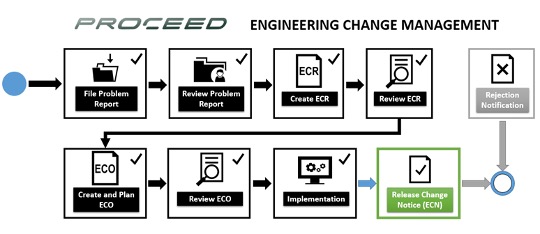Webinar

Of course, the reverse holds true. Done poorly, an ECM process can lead to bottlenecks, flawed decision-making, higher costs and increased errors. Your team might run into duplicate change requests or some requests might fall through the cracks. Supporting documents are often missing when you want to check the background of a certain design change – or they’re stored across a variety of hard drives, CRM and ERP systems, servers and file shares, which makes it tough for you to determine which information is up to date and which isn’t.
Oversight can also be an issue. How many changes are currently underway? What are the deadlines your team has to meet or the costs involved? It’s probably hard to say, since you can’t view all ECRs in one place – nor can you track their status. Then there’s your approval process, which is likely to be manual and slow.
There’s also the lifecycle length of an engineering change order (ECO) to consider. The longer it takes to complete a change, from initial concept to launch, the longer your team is diverted from working on new, value-adding projects. While minor ECOs might take just a week or less to process, medium complexity ECOs might take a few weeks – and major ECOs, such as a product line redesign, often take five months or more.
It’s no mystery why so many organizations want to sharpen and accelerate their ECM process – in doing so, they can drive stronger revenue and gain a competitive edge.
Unleashing Smarter ECM with PROCAD

- Capabilities that not only link your data and documents but track dependencies, from concept to design to validation to production
- Clear and accurate records that document the history and evolution of a changing product
- Change oversight, from task assignment to deadline monitoring to reports and analytics
- Digital sign-offs for change traceability and audit compliance
- Connected relationships in the engineering change orders, revisions and reviews even after all changes have been made
- Contextual tools for escalation, approval processes and status checks
- Centralized, immediate access to all documentation for all relevant team members
- Automation of processes and time-consuming tasks
PRO.FILE and PRO.CEED extend smarter ECM through the entire product lifecycle – from planning and implementation to production. The results include faster approvals, faster time to market, higher product quality, cost savings, and a more efficient team that can get started on profitable projects instead of re-doing tasks that weren’t done right the first time. In today’s complex engineering environment, where leaders must manage multiple teams and numerous documents across that lifecycle, no other tools help engineering changes go quite as smoothly – or drive more impressive end results.
For more information on ECM, download our eBook, Digitally Connecting Product-Related Data and Documents throughout your Enterprise

